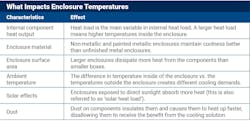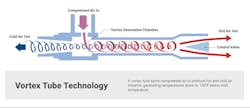A Guide to Protecting Electrical Enclosures From Heat
Download this article in .PDF format by clicking the download button below.
Inside an electrical enclosure, every 18°F rise in temperature reduces the reliability of the electronic components by 50%. As technology advances, electronics get smaller, leading to more electronic components inside a single enclosure. These tightly packed components help conserve space and allow for more efficient automation but leave very little room for heat dissipation and airflow circulation, contributing to higher internal temperatures which can lead to electronic overheating, control failures, and system shutdowns.
To combat system failure, it's crucial that cabinets are fitted with an enclosure cooling system. Many types of enclosure cooling devices are available: passive cooling types (fans, blowers, heat sinks, and heat exchangers) and active types (air conditioners, thermoelectric devices, and vortex coolers). There are pros and cons to each method, depending on what the specific application is.
It's key to consider the following factors when selecting an enclosure cooling product: heat load, enclosure location, and solution type.
Heat Load
The most important thing to consider when selecting an electrical enclosure cooler is the unit’s total heat load, which is made up of two main components. First is the internal heat load; the heat that's generated by the electric components inside the enclosure. Second is the external heat load; this is the amount of heat that's either gained or lost through the walls of the enclosure.
The internal heat load can be found in three different ways:
- The user knows the amount of heat that the electronics create (in either watts or btu/h).
- The user knows the total power that all the electric components consume. Then we can estimate that about 10 to 15% of this is generated as heat load (assuming electronic efficiency is between 85 to 90%).
- The user measures the existing temperatures inside the enclosure at the top of the unit and the existing temperature outside of the enclosure. The difference between these temperatures, along with the total surface area of the enclosure that is subject to the temperature difference, allows for the calculation of the internal heat load.
If the desired temperature inside the enclosure is less than the temperature outside the enclosure, then there's a heat load gain in the enclosure. Heat load gain depends on the difference in temperature, the amount of surface area that's subject to the temperature difference, how thick the enclosure walls are, if the enclosure is insulated or not, and the enclosure material. In this calculation, the external heat load is then added to the internal heat load to get the total heat load.
If the desired temperature inside the enclosure is greater than the temperature outside the enclosure, there's a heat load loss from the enclosure. This loss is then subtracted from the internal heat load to get the total heat load.
A helpful tool to get a better understanding of enclosure cooling capacity needs is this heat load calculator.
Location of Enclosure
When selecting an enclosure cooler, it’s important to consider what type of environment the unit will be placed in. While we already talked about the effects of the sun and heat, the outside elements and operation hazards need to be considered as well.
Outside
If an enclosure is subject to the outdoors (think rain, wind, ice, and frost) it’s important that the enclosure cooling system has a NEMA 4 or 4X rating. This is important to ensure that the interior of the enclosure remains dry and clean.
Inside
When placed indoors, and not subjected to a washdown operation or hazardous environment, typically a NEMA 12 enclosure cooler is suitable.
Washdown
In washdown operations, a NEMA 4X enclosure cooler is needed to maintain the sanitary conditions in the facility and to ensure that the washdown solution does not enter the enclosure.
Hazardous Locations
If the enclosure is situated in one of several hazardous locations, it’s vital to comply with IECEx, ATEX, and UL recommended system requirements.
Temperature Control Needs
Most enclosure cooling methods use a thermostat to monitor the temperature inside the electrical enclosure and regulate the operation of the cooling device to keep the temperature within an acceptable range. On average, most operations want to keep the enclosure temperature between 80 to 104°F (27 to 40°C). Most thermostats are electrical types and can be adjusted by the user to set the temperature as desired.
Some cooling methods, however, such as vortex cooling, can also use a mechanical type of thermostat that requires no electricity to operate. By eliminating the need for electricity to operate the cooling device, vortex cooling is ideal for use in enclosures in hazardous locations. For enclosures not located in hazardous areas, vortex cooling can be regulated using either an electric or manual thermostat.
Fan Cooling Systems
Fans are typically the most affordable option but can also be the least successful. Fans are constrained in their cooling capabilities: they allow little to no cooling adjustability and are reliant on the ambient air temperature. When factories have nearly invisible oil, aerosols, dust, and other contaminants in the air, a fan draws these contaminants into the cabinet and onto electronics and circuit boards. Although this air may temporarily cool the components, it deposits contaminants on the electronics, effectively insulating the electronic components. Eventually, this will cause the electronics to overheat, defeating the purpose of the fan in the first place.
Thermoelectric Cooling Systems
Thermoelectric coolers use the Peltier effect to create cooling by converting an electric current to create a cold junction and a hot junction. Fans blow air across the cold junction (a heat sink) to cool the air inside the enclosure. This cooling method has no moving parts and uses very little power. However, it's usually more expensive to purchase than other cooling types and therefore is primarily used in military and aerospace applications.
Refrigerant (“Freon”) Based Cooling Systems
Refrigerant-based cooling systems are more effective than fans, but they are limited in the environments in which they can operate. They typically do not function in ambient temperatures greater than 131°F (55°C). Refrigerants typically require an extensive physical footprint and higher upfront costs. In addition to the high upfront cost, refrigerant-based systems need periodic maintenance which costs additional time and money. Although an effective cooling option, they can become very time-consuming and costly to maintain properly.
Vortex Cooling Systems
Vortex cooling is an effective, safe, and low-maintenance way to cool enclosures. And while vortex cooling uses compressed air, thermostatically controlled systems minimize compressed air usage to reduce operational costs. Vortex tube technology converts compressed air into cold air without the use of electricity or coolants. Vortex cooling can reduce the temperature of the compressed air by 50°F (28°C) or more. This means that enclosures are supplied with cold, slightly pressurized air, while oil and dust are also prevented from entering the cabinet.
Vortex cooling systems have no moving parts, so they require very little maintenance, apart from occasionally changing a filter element, which ensures clean, dry air enters the enclosure. Vortex coolers are built to last and provide years of dependable cooling to ensure facility processes continue operating smoothly.
Conclusion
Each cooling system has its pros and cons, but what we all can agree on is having one of them is better than none. Every application is different and has specific demands. It's important to pick a cooling solution that is appropriate for your application, to prevent malfunctions and shutdowns.
For more information on how to keep your enclosures safe and productive, contact one of our experienced engineers to discuss your application needs at [email protected].


